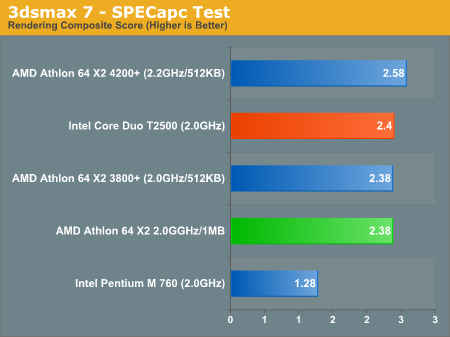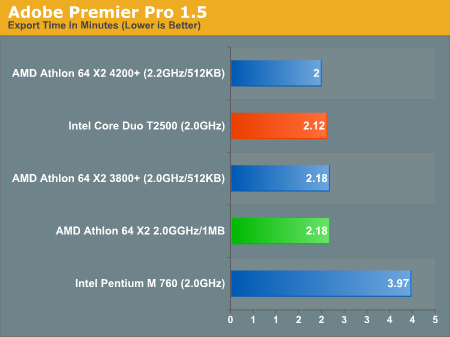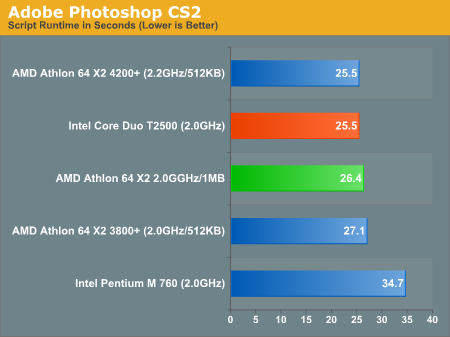Intel Core Duo (Yonah) Performance Preview - Part II
by Anand Lal Shimpi on December 19, 2005 12:55 PM EST- Posted in
- CPUs
Professional Application Performance with 3dsmax, Adobe Premier and Photoshop
We start off our page on professional application performance with an updated version of the SPECapc 3dsmax test, updated for version 7 of the application. The scenes being rendered haven't actually changed, but the reference numbers used to compute the composite scores have, so these scores aren't directly comparable to results from earlier SPECapc tests.
Compared to the Athlon 64 X2, the Core Duo comes out on top, but by a very small margin - once again we're faced with a virtual tie.
The breakdown of the rendering composite score can be found below; the scores in the table are render time in seconds, lower numbers are better:
Moving onto Adobe Premier Pro 1.5, this test is actually one that is used by Intel to showcase the performance of the Pentium 4 processor. With the Pentium 4 absent from this comparison, we were curious as to how it compared to the Core Duo and the Pentium M.
As with virtually any media encoding performance, dual-core processors do extremely well, and this case is no different with the Core Duo T2500 seriously outpacing the Pentium M 760.
The Core Duo T2500 is also able to complete the export process in about 97% of the time of the Athlon 64 X2, which once again ends up being borderline negligible for this test, but it is important to note that this advantage comes without the aid of an on-die memory controller.
Our final test is the only other Intel-supplied test in the suite. This one used to showcase the Pentium 4's performance under Adobe Photoshop CS2 by measuring the time that it takes to run a few filters and resize/export images. The script itself is fairly realistic; however, with Photoshop filters, it is easy to favor one architecture over another, so by no means are these numbers intended to be conclusive of Photoshop CS2 performance.
We start off our page on professional application performance with an updated version of the SPECapc 3dsmax test, updated for version 7 of the application. The scenes being rendered haven't actually changed, but the reference numbers used to compute the composite scores have, so these scores aren't directly comparable to results from earlier SPECapc tests.

Compared to the Athlon 64 X2, the Core Duo comes out on top, but by a very small margin - once again we're faced with a virtual tie.
The breakdown of the rendering composite score can be found below; the scores in the table are render time in seconds, lower numbers are better:
| SPECapc 3dsmax 7 Breakdown | AMD Athlon 64 X2 4200+ | AMD Athlon 64 X2 3800+ | AMD Athlon 64 X2 2.0GHz/1MB | Intel Core Duo T2500 | Intel Pentium M 760 |
| 3dsmax 5 rays | 15.406 | 15.829 | 16.109 | 14.297 | 25.246 |
| CBALLS2 | 20.125 | 22.281 | 22.094 | 21.187 | 42.201 |
| SinglePipe2 | 92.844 | 101.906 | 101.922 | 107.359 | 203.492 |
| UnderWater | 142.938 | 157.219 | 156.203 | 169.188 | 316.055 |
Moving onto Adobe Premier Pro 1.5, this test is actually one that is used by Intel to showcase the performance of the Pentium 4 processor. With the Pentium 4 absent from this comparison, we were curious as to how it compared to the Core Duo and the Pentium M.

As with virtually any media encoding performance, dual-core processors do extremely well, and this case is no different with the Core Duo T2500 seriously outpacing the Pentium M 760.
The Core Duo T2500 is also able to complete the export process in about 97% of the time of the Athlon 64 X2, which once again ends up being borderline negligible for this test, but it is important to note that this advantage comes without the aid of an on-die memory controller.
Our final test is the only other Intel-supplied test in the suite. This one used to showcase the Pentium 4's performance under Adobe Photoshop CS2 by measuring the time that it takes to run a few filters and resize/export images. The script itself is fairly realistic; however, with Photoshop filters, it is easy to favor one architecture over another, so by no means are these numbers intended to be conclusive of Photoshop CS2 performance.

Overall System Performance using WorldBench 5
Media Encoding Performance with DVD Shrink, WME, Quicktime and iTunes










103 Comments
View All Comments
Hacp - Monday, December 19, 2005 - link
If you want performance of an AMD X2 in a notebook package, the Yonah duo is the way to go.Griswold - Monday, December 19, 2005 - link
Or you wait for dual core Turion. Same thing.Accord99 - Monday, December 19, 2005 - link
But at 2-3x the power consumption.Houdani - Monday, December 19, 2005 - link
http://www.anandtech.com/cpuchipsets/showdoc.aspx?...">http://www.anandtech.com/cpuchipsets/showdoc.aspx?...No need to exaggerate unnecessarily.
Accord99 - Monday, December 19, 2005 - link
That's a system power consumption, I was referring to CPU only. And in a laptop environment, the power usage of the other components are much smaller so the impact of the CPU portion is greater. 90nm single Turions are already uncompetitive with Yonah, making them dual core will just make it worse.saratoga - Monday, December 19, 2005 - link
The difference will most likely be less then 2x judging by the relative power consumption of Dothan and Venice @ 90nm, so you're still wrong.Also, Yonah is a 65nm chip. It should not be surprising that it has an edge over 90nm chips.
Accord99 - Monday, December 19, 2005 - link
Dothan vs Turion ML has a 2X or greater edge under load. Yonah has comparable power consumption to Dothan while 90nm dual core Turions will clearly go up. 3X is not out of the question for non-undervolted DC Turions.Shintai - Monday, December 19, 2005 - link
Ye I would guess on something like 35W will be 40-45W with 65nm Turion X2, unless you sacrifice speeds. The 25W part might be 35-40W.But Turion really never had a chance, since it´s not designed for low power. And as we already saw in the benchies. Who want a dualcore Turion running at 1.8Ghz or less against a 2.13Ghz Yonah when the yonah uses less power.
Intel briliant move so Dothan->Yonah only gave 9% more transistors. Turion->Turion X2 will add 110-120% more transistors (Over 100% due to crossbar between CPUs).
So Yonah will also be cheaper to make than a dualcore Turion.
Furen - Thursday, December 22, 2005 - link
Intel did slice the "cache per core" in half with Yonah, so AMD could conceivably make Dual-core Turions have 512k per core, which would make the die-size increase around 50%, though this will probably have a greater impact on performance on the AMD side, since Dothan's cache was insanely huge to begin with.About the price: AMD Turions will always be cheaper than their direct analogs from Intel because AMD needs to perform the same AND have a better price for people to use it, otherwise they'll go with the market leader, so I dont think we'll ever be faced with chosing between a 1.8GHz Turion and a 2.13GHz Yonah. This is regardless of the production cost, though AMD's margins may take a big hit if Intel pushes prices hard enough.
bob661 - Monday, December 19, 2005 - link
pnw3d